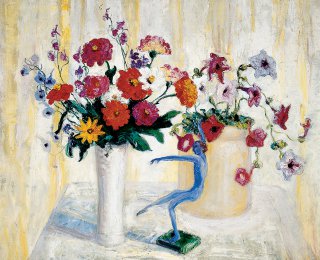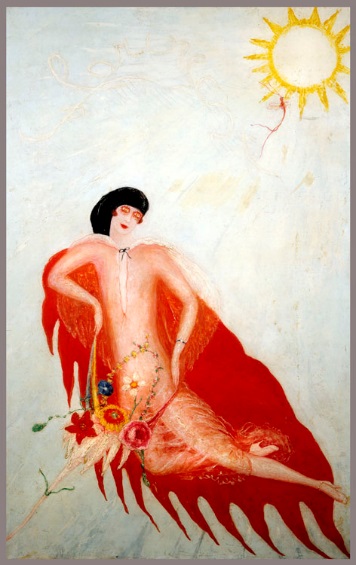
Florine Stettheimer
Flowers Number 6
(1871–1944)
American c. 1910 Oil on canvas 30 x 36 inches Gift of the Estate of Ettie Stettheimer 1965.133
Almost Forgotten
This lyrical still life was painted by Florine Stettheimer, a prominent member of the New York avant-garde scene who refused to concede to the demands of the art market. While Stettheimer produced numerous paintings throughout her life, she also tried to prevent them from ever reaching the public eye.
A Day in the Life
A Woman’s Place is Anyplace
Florine Stettheimer and her sisters were some of the “New Women” of the early 20th century. The women’s rights movement had achieved more job and education opportunities for women and, particularly for the wealthy, facilitated gender roles that defied tradition.
The Stettheimers never married – the artist Marcel Duchamp fondly referred to Florine as a “bachelor” – and as New Women pursued their own intellectual and artistic interests in lieu of conventional homemaking duties. Florine educated herself in art history by touring European museums, was known to wear pants rather than the traditional feminine dress while painting, and often depicted herself and other artists androgynously, like in the self-portrait featured here.

Florine Stettheimer, Portrait of Myself, 1923. Courtesy of Joseph and Alan Solomon.
Tools and Techniques
Behind the Scenes
Look Closer
How Did She Do It?
Much of Florine Stettheimer’s work focuses on her personal life and interests. She loved flowers, and not only included them in poetry and paintings, but also fashioned them out of metal and other materials. Flowers Number 6 is Florine’s creative interpretation of a few household objects, executed in the artist’s signature style; jewel-tone colors and sinuous lines animate the still life, so that the flowers seem to dance with the twirling figure.
Answer the questions below to discover more about this painting.
What elements of the painting heighten the intensity of the jewel-tone colors?
Thick paint application.
Large swaths of neutral colors.
Gestural brushwork.
Which features draw the viewer’s eye around the composition?
Recurring colors.
The lines created by the blue figure and flowers.
Both of the above.
Just for Kids
Signs & Symbols
Dig Deeper
Arts Intersected
From Brush to Pen
In addition to painting, Florine Stettheimer also designed stage sets and costumes, and wrote several poems that were published in 1949 under the title Crystal Flowers. The poem below was included in this volume.
The Unloved Painting
I was pure white
You made a painted show-thing of me
You called me the real-thing
Your creation
No setting was too good for me
Silver–even gold
I needed gorgeous surroundings
You then sold me to another man
Courtesy of Joseph and Alan Solomon
The Sculpture Speaks
Did You Know?
Expert Opinion
Look Around
About the Artist
Late Bloomer, by Choice
Florine Stettheimer, her mother, and two sisters were wealthy women who hosted numerous salons in their New York apartment in the early 20th century, inviting bohemians and intellectuals like Marcel Duchamp, Georgia O’Keeffe, and Alfred Stieglitz to display and discuss art. Stettheimer herself was a prolific art maker, but saw her paintings as intimate objects, generally only showing them to friends and fellow artists. She declined repeated offers for gallery representation, rarely exhibited, and instructed that her paintings be burned upon her death, a demand her sister Ettie ignored by donating them to various museums, including The DAI. Because of this history, her work has only gained recognition among art historians quite recently.
Talk Back
Do you think Florine Stettheimer’s lack of notoriety is a reflection of her skill as an artist? Why or why not? How does the art market–institutions such as museums, art houses, or galleries–influence the way we judge art?
